Even from the stories of Jack London, many remember the persistence of gold diggers, a smile of fortune, extraction methods "sunny" nuggets.
Is it possible these days to find gold in stones? Let's figure it out.
Noble solar metal in the field, indigenous deposits, what it looks like, locations
Precious metal can be found among rocks, mountains, ore, lake and sea sand. Natural reserves are limited, and throughout its history mankind has extracted about 200,000 tons of it metal.
In nature, the precious metal looks very different from what it looks like on the shelves of jewelry boutiques. It can be in many different shades, from grayish-emerald to scarlet.
Particles of the solar metal are present in many different stones, but in such tiny quantities that they have no value. A person wishing to engage in serious gold mining will have to count on fortune and know the principles of calculating deposits.
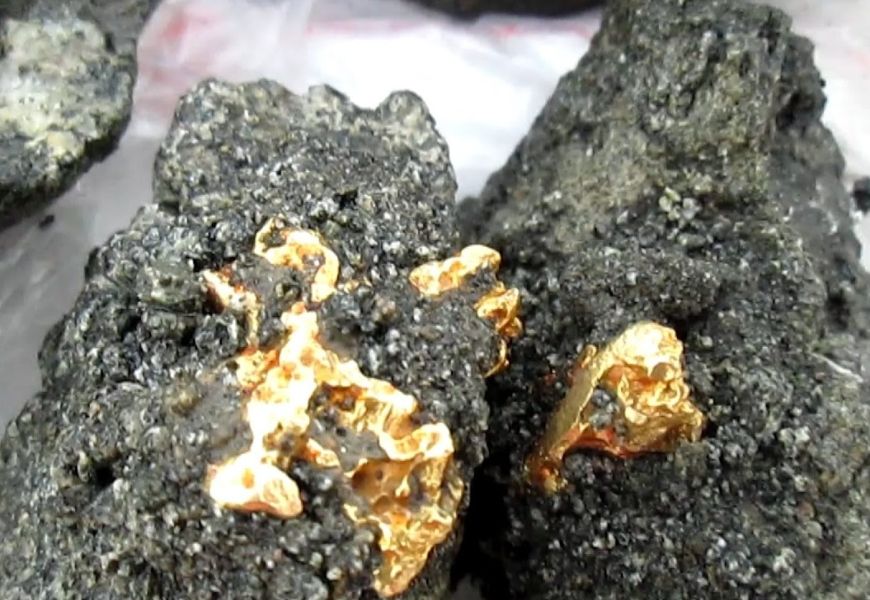
The most common place of metal localization are quartz formations. This is where they find large nuggets. At river bottoms detect bottom sediments.
The deposits are accompanied by the corresponding rocks.
The presence of magnetite and, as a consequence, black, purple or even red soil indirectly indicates the presence of gold in the rock.
Alluvial deposits, 3 types of placers of gold in nature
Alluvial or exogenous are referred to as loose gold-bearing sediments formed on the surface due to the destruction of bedrock deposits.
The placers can be eluvial, dealluvial, and alluvial.
- Eluvial placers occur in watershed areas, they are usually small in size, and their material contains large amounts of clay.
- Deluvial placers are often formed due to downslope displacement of eluvial placers. Industrial deluvial deposits are formed by the destruction of rich bedrock springs.
- Alluvial are those pieces of metal that have been carried by a water current to another location. They are most often found in river valleys, dried up riverbeds, and gorges. Alluvial placers are particularly abundant in the Pre-Ural Trough.
The method of placer mining has been relevant since antiquity. The myth of Jason, who searched for the golden fleece, is clearly inspired by one of the oldest methods of mining the precious metal.
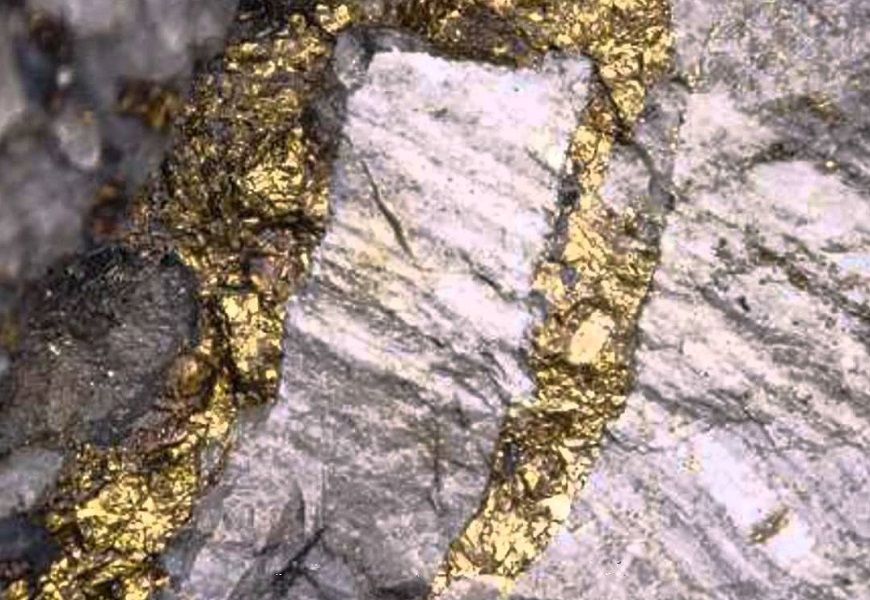
What rocks contain gold?
For a person who is new to gold mining, it is difficult to determine whether a stone contains a precious metal. Pure gold is practically unheard of, and its alloys come in various shades and intensities of luster.
So, what stones contain gold? Let's find out.
Magmatic body
The metal is most often found in intrusive rock formed with magma outcropping to the surface.
Quartz Crystals
Quartz is one of the most common minerals on Earth; its name translates as "hard. It is a true companion of gold, but not all crystals contain it.
Quartz veins attract a lot of attention from miners. Such ore masses contain gold metal especially often.
Gold-bearing quartz can be yellow, brown, blue or gray in color because of the presence of sulfides. Sulfides are another companion of gold.

Sand of mountain rivers and streams
The sand may contain small gold particles that look like pellets or pieces of wire.
Granite
Gold in granite is found no less frequently than in quartz, but to extract the metal from it without special equipment is not possible.
How to test a stone for gold
Solar metal can easily be confused with pyrite. At the time of the Mexican conquistadors, the Spanish conquistadors loaded their ships with pyrite, mistaking it for gold.
There are two reliable ways to help identify the real precious metal:
Scratch
The easiest way to check is to scratch the gilded surface with a thin needle. The result should be evaluated through a magnifying glass. Solar metal does not crumble under mechanical action.
Place in sulfuric acid
You can try placing the particles you find in a test tube of sulfuric acid. The next thing to do is to see what the reaction will be. If there is no reaction, you can conclude that the find really turned out to be gold.
It is also possible to distinguish the precious metal from the "cheaters" with iodine and verdigris.

Who can extract gold from stone by law
It is forbidden on the territory of Russia gold mining individuals. There is administrative responsibility for violation, a fine from 3 to 5 thousand rubles and confiscation of the precious metal. Criminal liability arises only if a particularly large-scale illegal mining.
Now mining of metal is allowed not only to large organizations, but also to individual entrepreneurs who have the appropriate license for 5 years.
3 ore processing options in the search for gold
Obtaining pure metal from gold stones - The task is not an easy one, requiring special techniques and knowledge of chemistry. There are three main ways of processing the ore, let's look at them in detail.
Chemical with aggressive acids
This method is characterized by contact of the ore with aggressive chemical reagents. To get a result, you need to choose the right acid that will dissolve the extraneous elements without affecting the gold. The precious metal will precipitate out.
The secret of the method is that it is almost impossible to dissolve gold with aggressive acids. Only concentrated chlorine, amalgam, and aqua regia are suitable for this purpose.
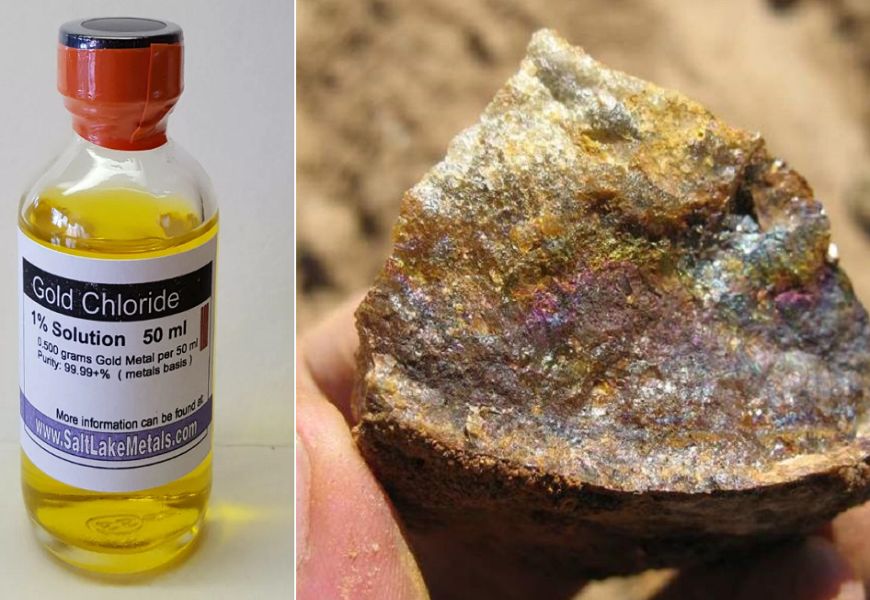
Dry by crushing the rock
This method is the most expensive, requiring compliance with increased safety measures.
With special equipment, stone rocks are crushed to dust. The resulting mass is subjected to a reaction with chlorine under enormous pressure.
The gold particles remain intact, while the other elements are gassed.
Popular electrolysis
This method will require a sufficient amount of raw materials and necessary chemicals.
An electric current is passed through the ore mixed with hydrochloric acid. The gold precipitates out as a precipitate.
With chlorine tin
The following described methods of ore processing are less popular, but effective.
First you take the powder of chlorine tin, mixed with water and hydrochloric acid.
The resulting chlorine mixture is added to the gold-containing solution. The reaction will last about a day. The golden sludgeThe precipitated material is boiled in hydrochloric acid.
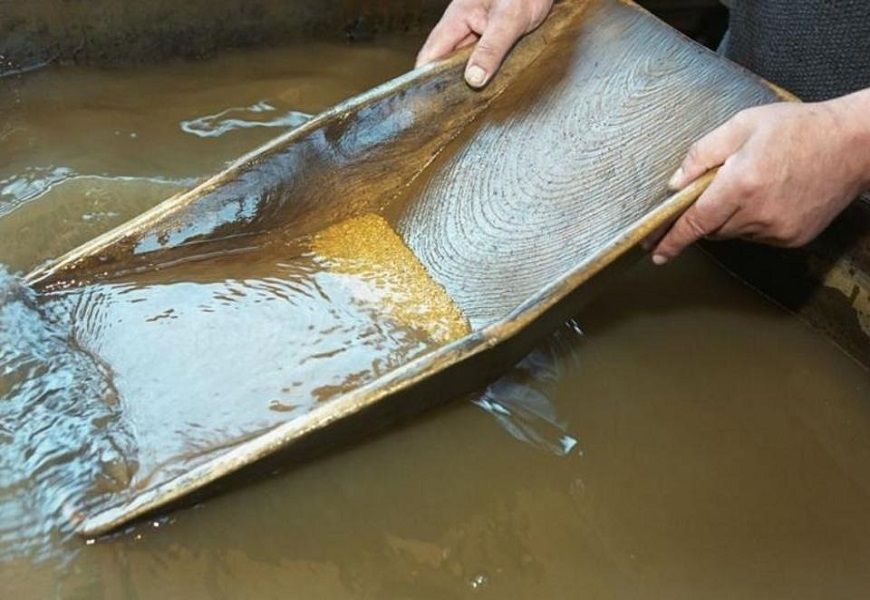
Washing of gold-bearing sand in mountain rivers
The precious metal is carried out of the gold-bearing rock and eroded by the river waters. You should look for the metal where there is no strong current and the river bed is quite wide.
An indirect sign that there is gold in the water is quartz grains.
Gold hunters move down the river with a flush tray. Particles of the precious metal are caught more frequently as they approach the deposit.
The sand contains tiny gold pellets at a depth of about 10 centimeters. If you wash the sand deeper, you will find larger nuggets, the largest of which should be looked for in the ground.
Miller's table and flushing with running water
This method is excellent for flushing in at home. You will need to buy or make a table Miller - a box 25 centimeters wide, 50 centimeters long. Stiff non-slip material is placed on the bottom. Metal sheet is not suitable, you can try to put linoleum on the bottom side.
The test material is washed under a continuous water flow. Light particles of various elements are washed away, while heavy gold grains are deposited.
You can buy such a table on eBay, the price ranges from $300.

Recycling with bleach
The first extraction of the precious metal with chlorine dates back to 1848. The essence of the method is as follows: water was poured into containers, chloride lime was added, and burnt ore was added. Sulfuric acid was poured on top, and then the vessel was sealed tightly.
The recovery of gold using this method from the ore is about 95%. Chlorine can be obtained by mixing bleach "Belize" with hydrochloric acid.
Geography of places attractive to miners. Gold-bearing rivers of Russia
You don't have to go to the Klondike to feel the spirit of gold rush. Russia is extremely rich in placer gold.
Around the first half of the 19th century the term "Siberian gold" appeared. The Irkutsk region and Krasnoyarsk Territory were rich in many gold deposits. They were discovered within the basins of the Ob, Tom and Yenisei rivers. Now the Siberian precious metal is the basis of the gold mining industry of the Russian Federation.
In Bashkiria, gold was found along the valleys of seven rivers in the Uchaly region. Here nuggets weighing about 16 kilograms were found. To date, gold mining in these areas is not actively developing, although it has excellent prospects.
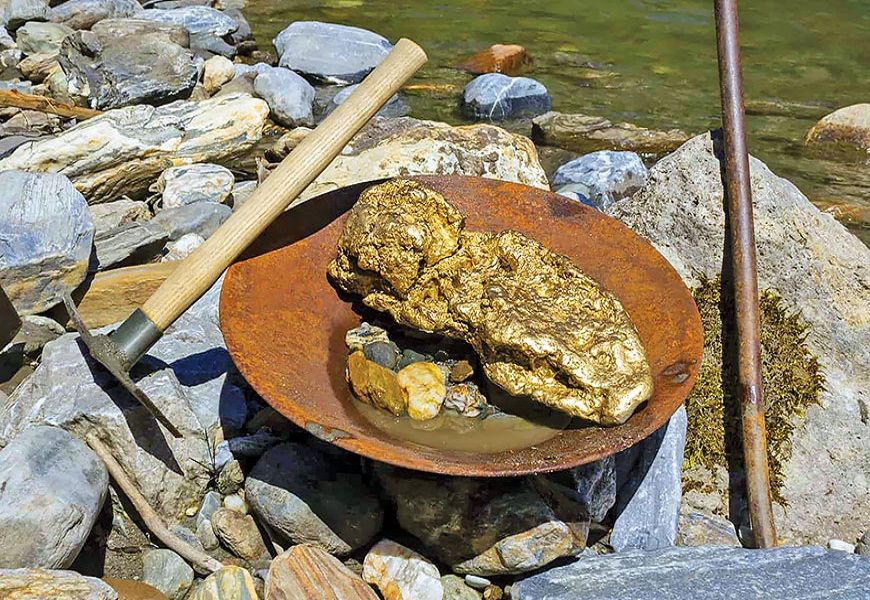
The rivers of Krasnodar Krai are worth noting separately. The right tributary of the Belaya River, the Kisha, is gold-bearing. Located south of the Adygea border, the Berezovaya River is also rich in grains of precious metal, and annually attracts prospectors.
The left tributaries of the Belaya, including Lipovaya, Bzykha, and Khamyshki, contain large-sized gold and nuggets can be found.
Places of gold laundering in other countries
Today's treasure hunters should pay attention to the following countries:
1. Republic of Ghana, West Africa: no legal restrictions, Tarkwa area includes 4 gold sites.
2. Indonesia: gold mining will require a license, which the local authorities even issue to tourists.
3. Norway: The mountain rivers of this country attract many miners every year; you need a license to launder gold.
4. Finland: the Ivailoki River is famous for the presence of scattered solar metal.
5. Australia: the most attractive country for gold prospectors, the authorities not only issue licenses to operate, but also the necessary equipment. It is worth visiting areas of the state such as Victoria and South Wales to launder the precious metal.
Video: how to extract gold from stone
How to get gold from a stone at home
It is possible to extract gold from stone at home. Determining the appropriate method refiningYou need to know all the basic characteristics of the precious metal.
Consider the method with the use of bleach.
First, the stone should be crushed by pre-firing with a burner. Only after that is the crushing equipment applied.
Most of the time, the gold in the rock is fine, and you can't see it with the naked eye. Therefore, the rock is crushed to dust with a crusher.
The crushed material needs to be filled with sulfuric acid and bleach. Common bleach for cleaning bathtubs will do. All the elements should be stirred to speed up the reaction, and then leave it for 6 hours. Next, proceed to filtration.
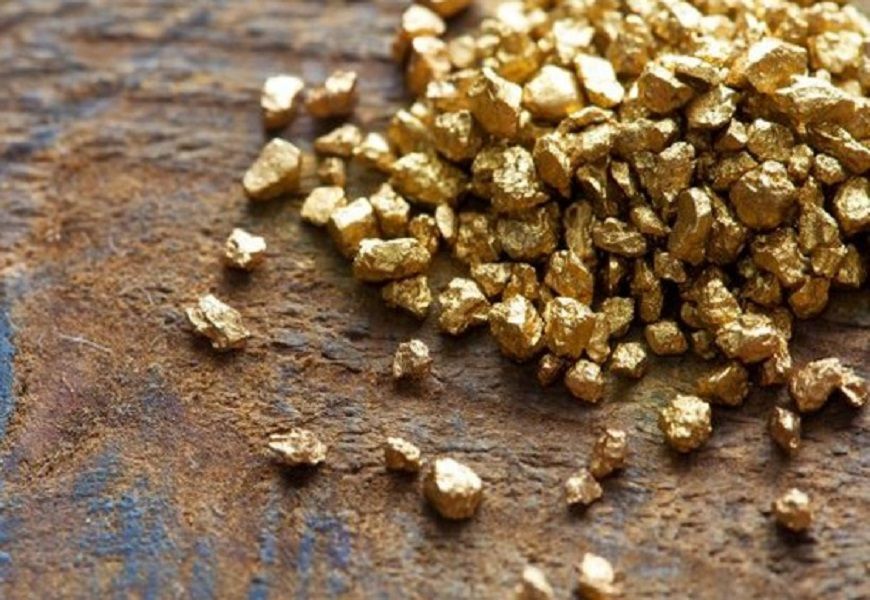
The filtration procedure is repeated until the liquid is lighter. The resulting solution is oxidized with hydrochloric acid and heated slightly, this is necessary to eliminate free chlorine.
The evaporated liquid must be filtered again, and then the gold must be separated by adding an inorganic compound of iron sulfate to the liquid.
The liquid must infuse, after which the top layer is drained. The container is calcined and dried, the solid gold will remain at the bottom.
Opinion of a prospector

To make mining profitable, one cannot do without knowledge; luck alone is not enough. The reality is that it is necessary to study a lot of material related to gold-containing stones, the intricacies of mining, and the geography of geological excavations. Legally on the territory of Russia you can mine the metal under a contract with a company that has a license.
